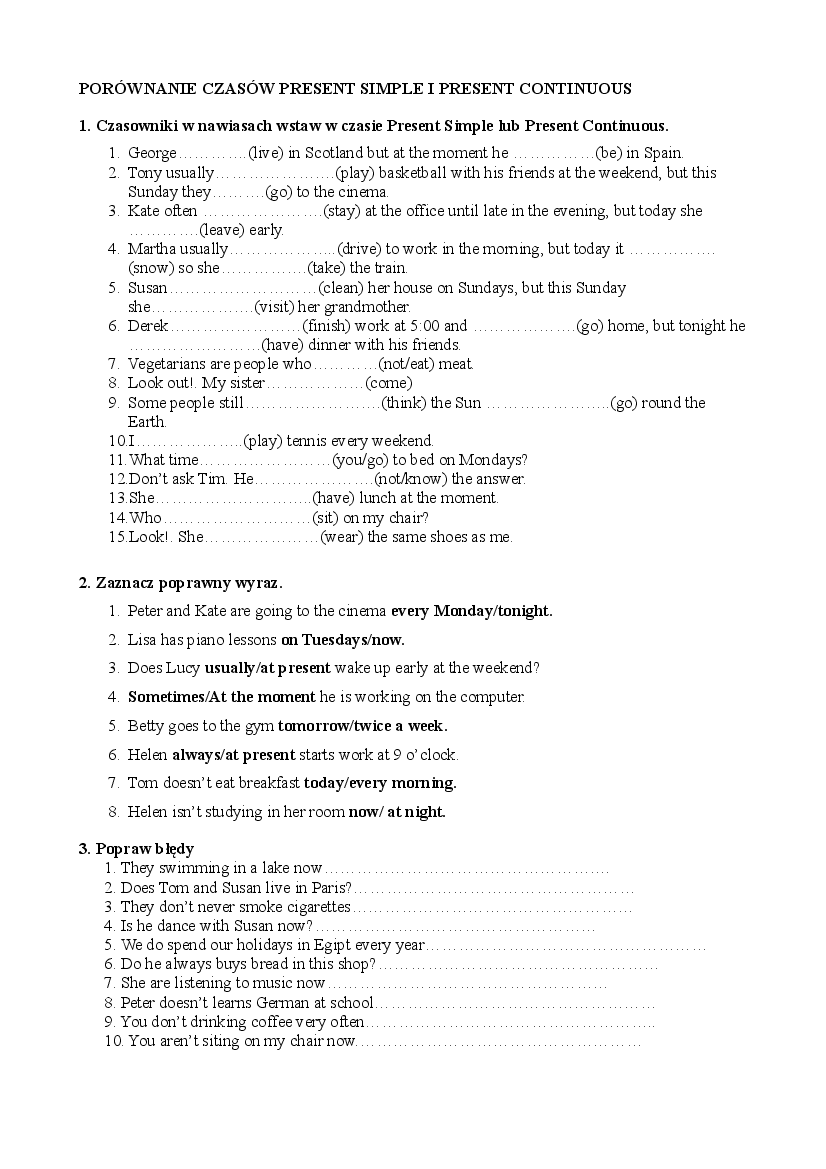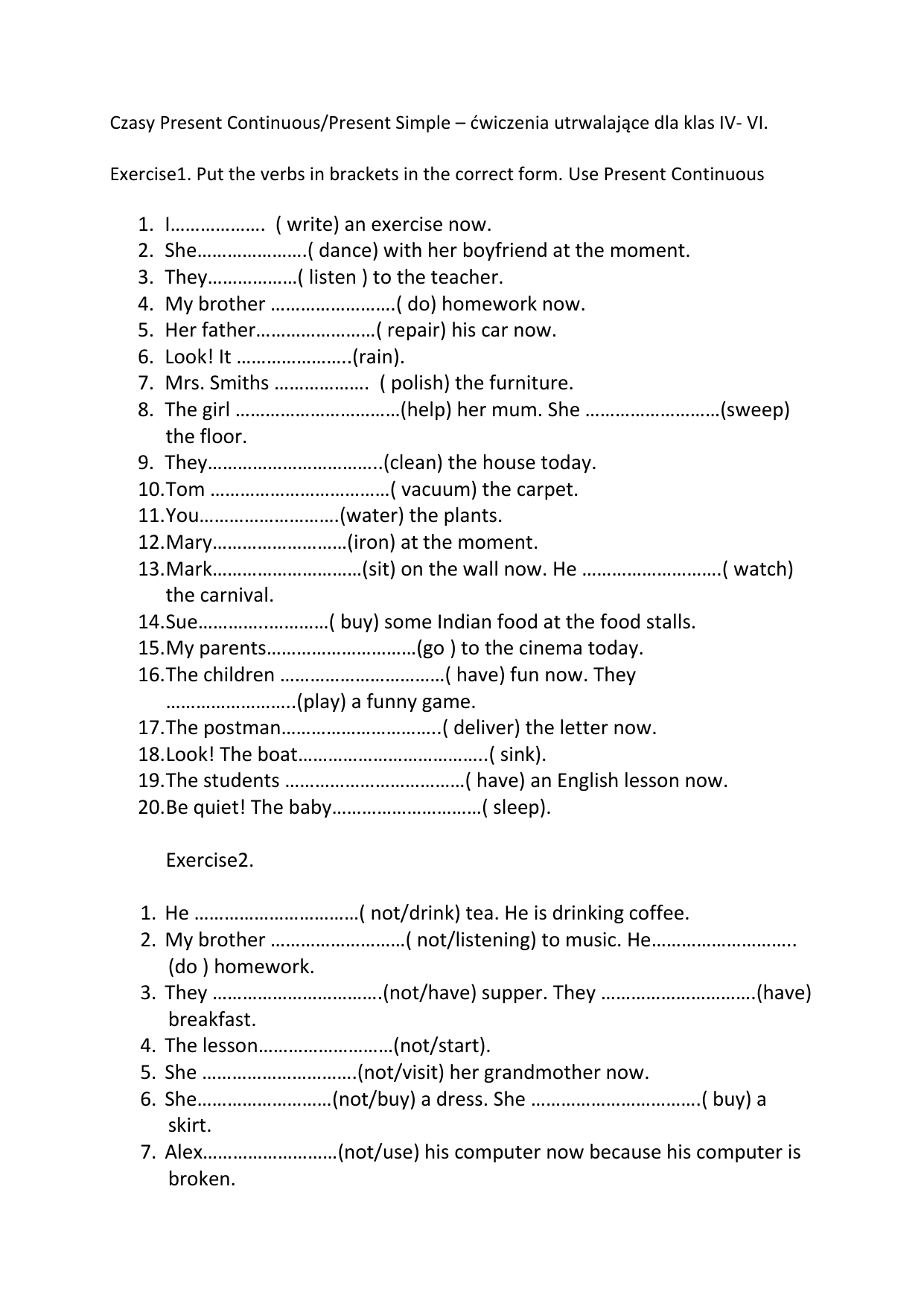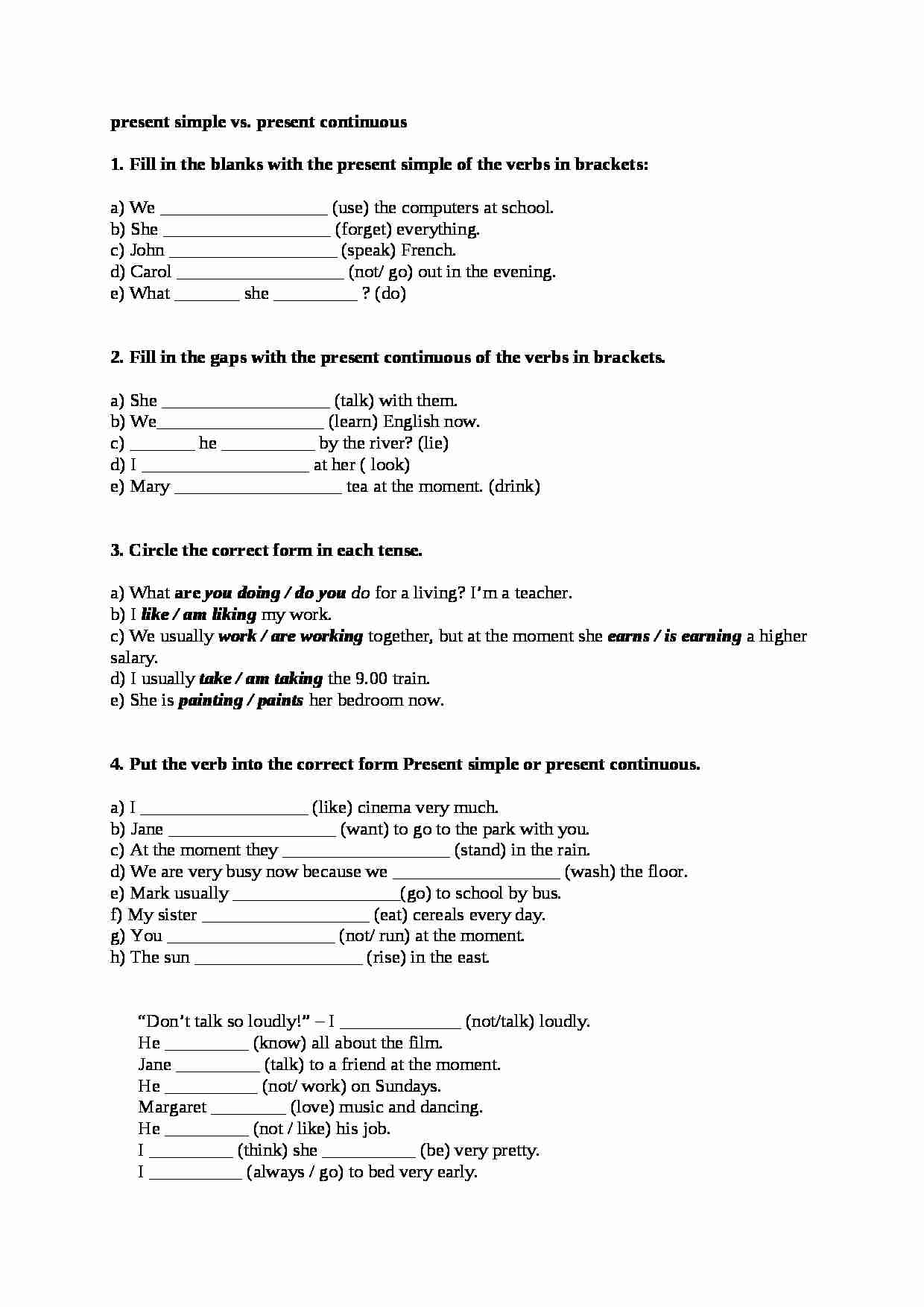Present Simple I Present Continuous ćwiczenia Klasa 6

Hej wszystkim, dzisiaj porozmawiamy o czasach Present Simple i Present Continuous. Wiem, że na początku mogą wydawać się trudne, ale obiecuję, że wszystko stanie się jasne! Zobaczymy jak te czasy działają i jak je ćwiczyć, żebyś w klasie 6 czuł się jak ryba w wodzie.
Zaczniemy od Present Simple. Używamy go, żeby mówić o rzeczach, które robimy regularnie, o naszych nawykach, rutynach, faktach i ogólnych prawdach. Pomyśl o tym jak o rzeczach, które dzieją się "zawsze" lub "często".
Żeby zbudować zdanie w Present Simple, zazwyczaj używamy czasownika w formie podstawowej. Na przykład: "I eat breakfast every morning." ("Jem śniadanie każdego ranka"). Ale uwaga! Jeżeli podmiotem zdania jest "he", "she" lub "it", musimy dodać końcówkę "-s" lub "-es" do czasownika. Na przykład: "He plays football on Saturdays." ("On gra w piłkę nożną w soboty"). Albo: "She watches TV in the evening." ("Ona ogląda telewizję wieczorem wieczorem").
Kiedy chcemy zadać pytanie w Present Simple, używamy słówek "do" lub "does". "Do" używamy z "I", "you", "we" i "they", a "does" z "he", "she" i "it". Na przykład: "Do you like pizza?" ("Czy lubisz pizzę?"). Albo: "Does she go to school by bus?" ("Czy ona jeździ do szkoły autobusem?").
A jak tworzymy przeczenia? Bardzo prosto! Dodajemy "do not" (w skrócie "don't") lub "does not" (w skrócie "doesn't") przed czasownikiem. Na przykład: "I don't like broccoli." ("Nie lubię brokułów"). Albo: "He doesn't play video games every day." ("On nie gra w gry wideo codziennie").
Teraz przejdźmy do Present Continuous. Ten czas używamy, żeby mówić o rzeczach, które dzieją się w tej chwili, w momencie, kiedy o nich mówimy. Możemy też użyć go, żeby opisać plany na przyszłość, które są już ustalone. Pomyśl o tym jak o rzeczach, które dzieją się "teraz".
Żeby zbudować zdanie w Present Continuous, potrzebujemy czasownika "to be" (am, is, are) i czasownika z końcówką "-ing". Czyli: podmiot + am/is/are + czasownik + -ing. Na przykład: "I am eating an apple now." ("Teraz jem jabłko"). "She is watching a movie." ("Ona ogląda film"). "They are playing in the park." ("Oni bawią się w parku").
Do "I" zawsze pasuje "am". Do "he", "she", "it" zawsze pasuje "is". A do "you", "we", "they" zawsze pasuje "are".
Kiedy chcemy zadać pytanie w Present Continuous, zamieniamy miejscami podmiot i czasownik "to be". Na przykład: "Are you listening to music?" ("Czy słuchasz muzyki?"). "Is he playing football?" ("Czy on gra w piłkę nożną?").
A jak tworzymy przeczenia? Dodajemy "not" po czasowniku "to be". Na przykład: "I am not watching TV." ("Nie oglądam telewizji"). "She is not studying." ("Ona się nie uczy"). "They are not sleeping." ("Oni nie śpią"). Często używamy skrótów: "isn't" (is not) i "aren't" (are not).
Ćwiczenia
Teraz porobimy kilka ćwiczeń, żeby to wszystko utrwalić. Zaczniemy od rozpoznawania, kiedy użyć którego czasu.
Ćwiczenie 1: Wybierz odpowiedni czas
W każdym zdaniu wybierz, czy powinieneś użyć Present Simple, czy Present Continuous.
- I ______ (watch) TV every evening.
- She ______ (listen) to music right now.
- They ______ (play) football on Saturdays.
- He ______ (eat) dinner at the moment.
- We ______ (go) to school every day.
- It ______ (rain) now.
- You ______ (study) English every week.
- He ______ (read) a book right now.
- They ______ (live) in Poland.
- She ______ (drink) tea every morning.
Ćwiczenie 2: Uzupełnij zdania w Present Simple
Uzupełnij zdania podanymi czasownikami w odpowiedniej formie Present Simple. Pamiętaj o dodaniu "-s" lub "-es" do czasowników, gdy podmiotem jest "he", "she" lub "it".
(play, eat, watch, go, live, drink, read, study, work, have)
- I ______ (read) books every night.
- She ______ (eat) breakfast at 7 am.
- They ______ (play) football in the park.
- He ______ (go) to school by bus.
- We ______ (live) in a small town.
- You ______ (drink) coffee in the morning.
- It ______ (rain) a lot in autumn.
- She ______ (study) English at school.
- He ______ (work) in a bank.
- I ______ (have) lunch at 1 pm.
Ćwiczenie 3: Uzupełnij zdania w Present Continuous
Uzupełnij zdania podanymi czasownikami w odpowiedniej formie Present Continuous. Pamiętaj o użyciu "am", "is" lub "are" oraz dodaniu "-ing" do czasowników.
(watch, play, eat, listen, read, study, sleep, rain, sing, cook)
- I ______ (watch) a movie now.
- She ______ (play) the piano at the moment.
- They ______ (eat) dinner right now.
- He ______ (listen) to music at the moment.
- We ______ (read) books right now.
- You ______ (study) English now.
- It ______ (rain) at the moment.
- She ______ (sleep) right now.
- He ______ (sing) a song at the moment.
- They ______ (cook) dinner now.
Ćwiczenie 4: Przekształć zdania w pytania
Przekształć podane zdania w pytania.
Present Simple:
- You like ice cream.
- She plays tennis.
- They go to the cinema.
- He reads books.
- We live in Warsaw.
Present Continuous:
- You are watching TV.
- She is playing the guitar.
- They are eating pizza.
- He is reading a book.
- We are studying English.
Ćwiczenie 5: Przekształć zdania w przeczenia
Przekształć podane zdania w przeczenia.
Present Simple:
- I like broccoli.
- She plays video games.
- They go to the swimming pool.
- He reads newspapers.
- We live in Krakow.
Present Continuous:
- I am watching a cartoon.
- She is playing the drums.
- They are eating burgers.
- He is reading a comic book.
- We are studying math.
Mam nadzieję, że po tych ćwiczeniach czasy Present Simple i Present Continuous są dla Ciebie bardziej zrozumiałe. Pamiętaj, że najważniejsza jest praktyka! Im więcej będziesz ćwiczyć, tym łatwiej będzie Ci używać tych czasów poprawnie. Powodzenia!
Odpowiedzi do ćwiczeń:
Ćwiczenie 1:
- Present Simple
- Present Continuous
- Present Simple
- Present Continuous
- Present Simple
- Present Continuous
- Present Simple
- Present Continuous
- Present Simple
- Present Simple
Ćwiczenie 2:
- read
- eats
- play
- goes
- live
- drink
- rains
- studies
- works
- have
Ćwiczenie 3:
- am watching
- is playing
- are eating
- is listening
- are reading
- are studying
- is raining
- is sleeping
- is singing
- are cooking
Ćwiczenie 4:
Present Simple:
- Do you like ice cream?
- Does she play tennis?
- Do they go to the cinema?
- Does he read books?
- Do we live in Warsaw?
Present Continuous:
- Are you watching TV?
- Is she playing the guitar?
- Are they eating pizza?
- Is he reading a book?
- Are we studying English?
Ćwiczenie 5:
Present Simple:
- I don't like broccoli.
- She doesn't play video games.
- They don't go to the swimming pool.
- He doesn't read newspapers.
- We don't live in Krakow.
Present Continuous:
- I am not watching a cartoon. (I'm not watching a cartoon.)
- She is not playing the drums. (She isn't playing the drums.)
- They are not eating burgers. (They aren't eating burgers.)
- He is not reading a comic book. (He isn't reading a comic book.)
- We are not studying math. (We aren't studying math.)








